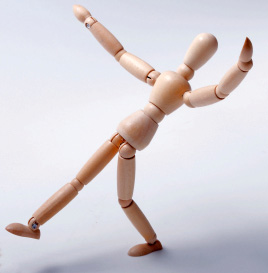 Everyone is in a hurry on the streets of Manhattan, streets that at times feel more like an obstacle course. From the crowds of people, uneven sidewalks, and not to mention pe- destrians obsessed with text messaging, a short walk to the corner store may prove to be a dangerous endeavor. If your balance systems are not fully functioning, you can quickly find yourself in a heap of trouble.
Everyone is in a hurry on the streets of Manhattan, streets that at times feel more like an obstacle course. From the crowds of people, uneven sidewalks, and not to mention pe- destrians obsessed with text messaging, a short walk to the corner store may prove to be a dangerous endeavor. If your balance systems are not fully functioning, you can quickly find yourself in a heap of trouble.
The statistics can be alarming. Nearly 1 million people visit the emergency room each year as a result of a fall, and falls are the leading cause of accidental deaths at home. Fur- thermore, each year approximately 6,000 people die from a fall. Non-fatal falls can also have serious consequences, often leading to physical injuries such as fractures, reduced activity level, and perhaps worst of all, developing a fear of falling. Falls can seem unavoidable, but are often a result of poor or impaired balance.
Balance is a broad term that relies on multiple systems, but in the most basic sense it is the ability to control and main- tain your body’s position as it moves through space. There are 3 types of balance
- Stability when you are standing or sitting in one place (Static Balance)
- Stabilization when you are in motion (Dynamic Balance)
- Helping you perform a specific activity (Functional Balance)
Your brain works together with muscles and joints of the body to maintain balance while relying on 3 forms of sensory input:
- Visual System – The most highly utilized system that allows sight to identify obstacles and potential danger
- Spatial System – This is your body’s internal sense of muscle and joint position
- Vestibular System – Located in the inner ear, a series of canals provide information regarding head position in relation to gravity. The end result is that your brain quickly processes incoming information and sends signals to your muscles to help keep you on your feet.
How can you prevent yourself from becoming a statistic? Physical therapy can provide a thorough evaluation of strength, range of motion, gait pattern, general mobility, symptom reproduction and assessment of the (3) balance systems. A series of standardized tests can also be used to identify your fall risk. Physical therapists utilize this information to develop a personalized treatment plan based on your symptoms, impairments and functional limitations.
Many people assume dizziness is a natural part of the aging progress and simply accept the unpleasant experience of a spinning room or lightheadedness. You may be surprised to discover an entire specialty of physical therapy is dedicated to alleviating these symptoms. Vestibular rehabilitation can address vertigo, dizziness, inner ear disorders, slow processing of balance information, and gait/balance disturbances. The frequency and duration of treatment sessions for balance rehabilitation varies depending on individual impairments.
In addition to seeking the care of a physical therapist, a few simple tips and tricks can make a big difference at home and in the community. To improve your safety at home, clear clutter, remove throw rugs, use a night light, and most importantly remember to take your time. When outdoors, use appropriate assistive devices, scan the environment, wear proper fitting shoes, and avoid multi-tasking.
Physical therapy treatment can be a viable and conservative approach to improve your balance. Changes in balance, vision or hearing and increased dizziness or nausea are not symptoms you must tolerate. Contact your primary care physician to initiate the process of recovery with a referral to your physical therapist.
Falls and injury prevention remain a considerable challenge for New Yorkers and health care professionals alike. Physical therapy treatment can effectively treat balance and many cases of dizziness/vertigo. All physical therapists are capable of providing balance therapy for general unsteadiness. A physical therapist trained in vestibular rehabilitation is able to provide specialized treatments (canalith repositioning, gaze stabilization, habituation exercises) for vertigo, in addition to balance therapy. Your health and well-being are a top priority to a physical therapist, as we aim to decrease fall risk, improve confidence and most importantly, impact your quality of life in a positive way.
Article By: Erin Ingram, PT, DPT
Therapist at Sutton Place Physical TherapyTrained in Vestibular Rehabilitation.



